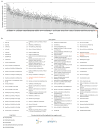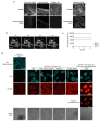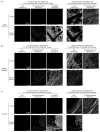This is a preprint.
Imaging the extracellular matrix in live tissues and organisms with a glycan-binding fluorophore
- PMID: 38766047
- PMCID: PMC11100790
- DOI: 10.1101/2024.05.09.593460
Imaging the extracellular matrix in live tissues and organisms with a glycan-binding fluorophore
Update in
-
Live imaging of the extracellular matrix with a glycan-binding fluorophore.Nat Methods. 2025 May;22(5):1070-1080. doi: 10.1038/s41592-024-02590-2. Epub 2025 Feb 6. Nat Methods. 2025. PMID: 39915692 Free PMC article.
Abstract
All multicellular systems produce and dynamically regulate extracellular matrices (ECM) that play important roles in both biochemical and mechanical signaling. Though the spatial arrangement of these extracellular assemblies is critical to their biological functions, visualization of ECM structure is challenging, in part because the biomolecules that compose the ECM are difficult to fluorescently label individually and collectively. Here, we present a cell-impermeable small molecule fluorophore, termed Rhobo6, that turns on and red shifts upon reversible binding to glycans. Given that most ECM components are densely glycosylated, the dye enables wash-free visualization of ECM, in systems ranging from in vitro substrates to in vivo mouse mammary tumors. Relative to existing techniques, Rhobo6 provides a broad substrate profile, superior tissue penetration, nonperturbative labeling, and negligible photobleaching. This work establishes a straightforward method for imaging the distribution of ECM in live tissues and organisms, lowering barriers for investigation of extracellular biology.
Conflict of interest statement
Competing Interests A patent application relating to this work has been filed by the Howard Hughes Medical Institute (internal reference 2024-017-01).
Figures













References
-
- Pedram K., Shon D. J., Tender G. S., Mantuano N. R., Northey J. J., Metcalf K. J., Wisnovsky S. P., Riley N. M., Forcina G. C., Malaker S. A., Kuo A., George B. M., Miller C. L., Casey K. M., Vilches-Moure J. G., Ferracane M. J., Weaver V. M., Laubli H. & Bertozzi C. R. Design of a mucin-selective protease for targeted degradation of cancer-associated mucins. Nat. Biotechnol. 1–11 (2023). doi:10.1038/s41587-023-01840-6 - DOI - PMC - PubMed
Publication types
Grants and funding
LinkOut - more resources
Full Text Sources
